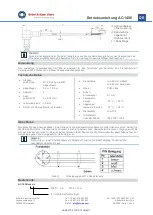
Section 4387
common. causing the output of
to go
If
rectifier output voltage is too low, the voltage
at the
of potentiometer
becomes
with
respect to common, causing the output of amplifier Al7
to go negative.
CR1 at
output of ampfifier
Al7 is used in conjunction
diode CR4 of the current
sense circuit to provide isolation of control between the
voltage and current regulating circuits. The current
sensing and current regulation circuit is connected into
the regulation circuit at the cathode of
At this
the voltage and current regulator circuits are con-
nected in an OR type configuration. Whichever regula-
tor output is more positiie controls the pulse and phase
control
The
of this OR
is con-
nected to an inverting voltage follower
gen-
erates a second
equal in
but of
to
me
signal generated by A17. The
positiie and negative error signals thus generated by
Al7 and Al8 are applied to the pulse generation circuits
where
me
error signal inputs are used to generate the
thyristor gate pulses.
and Current
8.11
This circuit senses the output current of the
fier and changes the operation of the
from
age regulation to current regulation when the output
current reaches a predetermined value. The
output of the rectifier is passed
meter shunt R25. The voltage
across the shunt
deflects the output ammeter and
provides a control
to the output current. This control
signal is applied to the input of shunt
A8
through resistors
and R28. Shunt amplifier A6 pro-
vides
output
voltage to
me
current
and toad
as well as the current regulator
circuit which
and regulates
output. The
current limit
of the rectifier is determined by a
series string of resistors connected at the output of
shunt
These resistors include CURRENT
LIMIT potentiometer
and resistors R17.
and
6.12
Resistor
wfth the temperature
sensing and fan fail circuitry. Resistor R17 is
shorted out by
contacts of
K3
are
connected at J4
11 and 12. When the temperature
of the rectifier heat sinks exceeds
or if
air
through the
ceases, resistor
is
inserted into the
to decrease the
output
current. Refer to the description of the temperature
sensing circuit for details.
Page 18
6.13 Resistor
is connected to the cathode of
diode CR3. When the rectifier is supplying less
current
the current limit
of potentiometer
the current
performs no regulation func-
tion. When output current exceeds the level set by
potentiometer
the voltage at the junction of potenti-
ometer
and resistor Al5 (34) causes amplifier A5
to generate an
signal. The current
error sig-
nal output of currant control
A5 is coupled to
the voltage control
CR4. This signal
causes
rectifier to operate in the current regulation
mode.
pulse Generation and Phase Control Circuits
6.14
This circuit card contains three identical pulse cir-
cuits, one for
AC phase. Each pulse circuit gener-
ates the firing pulse used to gate two
in each
phase. The pulse circuits control the phaseback angle
of the
in response to a signal from the voltage
regulator described previously. The firing circuit for
each
consists of a driver transistor which is
controlled by two comparators. a reference comparator
and a
comparator. The reference com-
parator receives an en-or signal from the regulator circuit
is compared to an integrated sine wave derived
from the power transformer Tl secondary winding. The
reference comparator utiiies this information to deter-
mine when to turn on the
transistor. The synchro-
nizing comparator
damping
to prevent
firing of the thyristor when
is reverse
6.15 The control of
angle based on a
comparison of a cosine reference
which leads
m.9
line by
against a
from the voltage regula-
tor circuit.
the circuit
contains three identical
phase control circuits, the operation ot the one may be
taken as typical.
cosine voltage is generated by an
integrator consisting of an operational amplifier
A4. resistors A9
Al0
and capacitor
Resistors A9 (5-10) and Al0 (5-10) and capacitor Cl4
the
to amplifier A4. The cosine voltage at
me output of A4 is applied to the inputs of two compara-
tors of
the voltages on the power
are
out of phase, it
that their corresponding
firing pulses must be 180’ out of phase. To develop two
signals wfth the same phaseback angle but
out of
phase with each
the cosine voltage is applied to
me non-inverting
of one
of
and to
me inverting input of the second comparator of
At
this
the
and
error signals gener-
ated by the regulator circuit are applied to the pulse
circuit. These error signals are equal in
I
I
I
I
I
I
I
I
I
I
I
I
Summary of Contents for LORAIN RHM800E50
Page 1: ...I I I I I I I I I I 1 I I I I I I I I LORAIN MODEL RHMSOOE50 RECTIFIER SPEC NO 548502500...
Page 3: ...I Section 2992 Issue July 2000...
Page 4: ...Section 2992 Issue July 2000 Marconi Page 2 of 2 I...
Page 26: ......
Page 31: ......
Page 32: ......
Page 33: ......
Page 45: ...Section 2968 FIGURE I 9EMlCONOUCTOR lOENllFlCAT0N OUTLINES USC TIR n a msma GCA I I I I Page 2...
Page 59: ......
Page 60: ......
Page 61: ......
Page 62: ......
Page 63: ......
Page 64: ......
Page 65: ......
Page 66: ......
Page 67: ......
Page 68: ......
Page 69: ......
Page 70: ......
Page 71: ......
Page 72: ......
















































